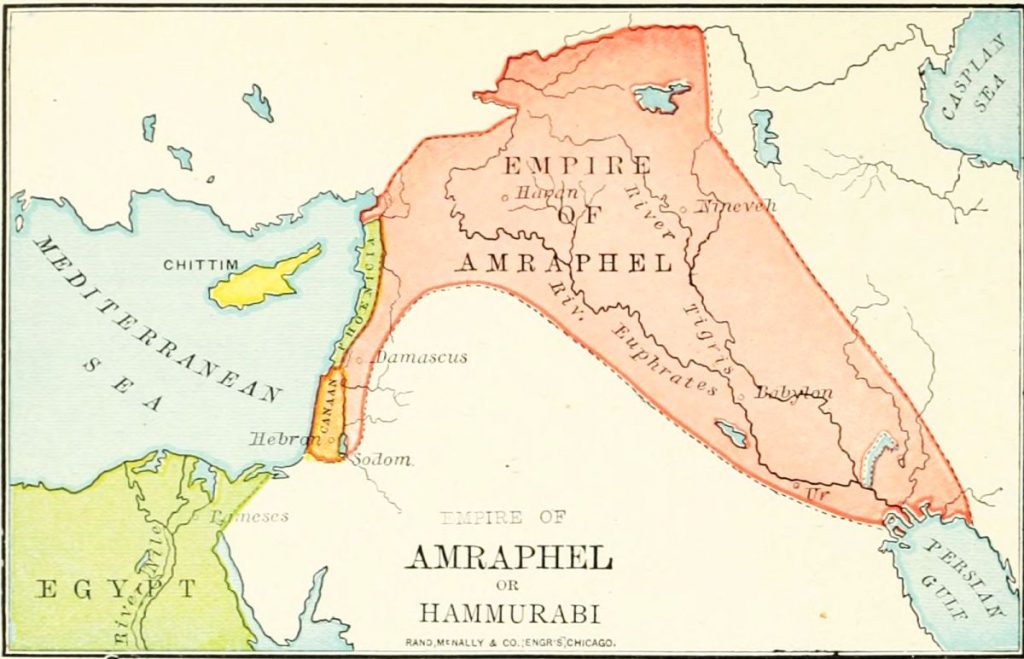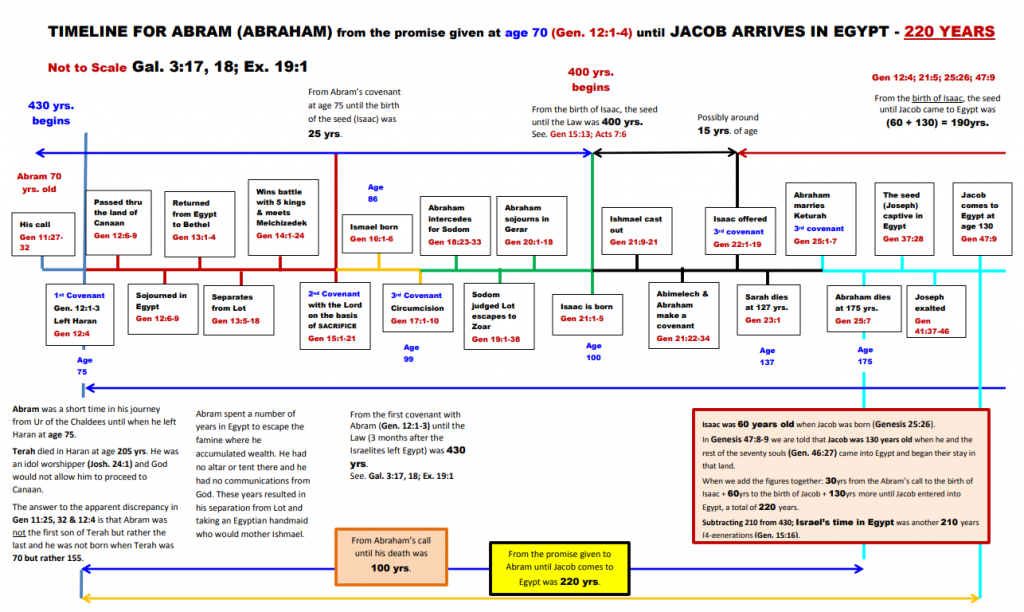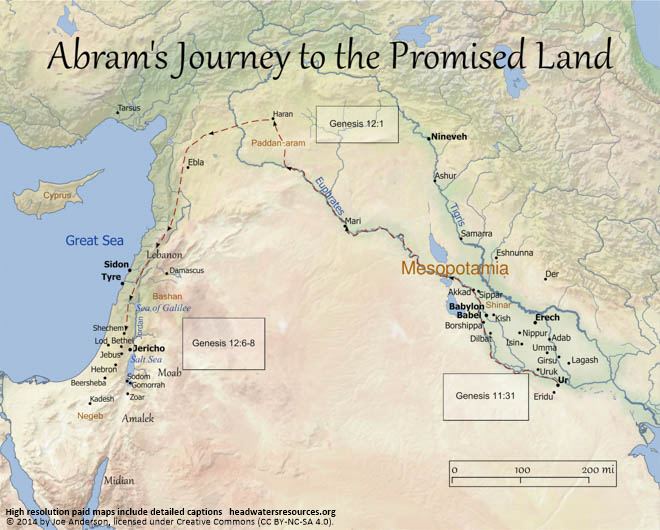At the close of the eleventh chapter of Genesis a change is made in the subject of the Bible story. Thus far it has been a history of the entire race; but from this point to the close of Genesis a single family is brought into prominent notice, and the rest of the tribes of men are referred to only incidentally. The family of Abraham, of Semitic origin, deserve all their prominence in sacred history, since through them the true religion was perpetuated until the world was ready for its wider dissemination in the gospel period.



These extend over nearly all the lands of the Old Testament, from Chaldea to Egypt. They represent the separation of a Semitic clan from the great body of the race, which was then ruled by an Elamite dynasty; and they bring to our notice the political relations of the world about two thousand years before Christ, in the early Chaldean period of the East.
1. From Ur to Haran. (Gen. 11:27-32)
The family of Abraham (then called Abram) lived at Ur of the Chaldees, probably Mugheir, south of the Euphrates, and an early seat of empire. Thence, at God’s call, they migrated, moving up the Euphrates to Haran, in Mesopotamia, probably the Roman Carrhæ, and the modern Haran, on the river Belik, 50 miles above its entrance into the Euphrates. Here the family remained until the death of Terah, Abraham’s aged father, whose traditional tomb is still shown.
2. From Haran to Canaan. (Gen. 12:1-9)
A branch of the family, the descendants of Abraham’s brother Nahor, settled in Haran; but Abraham and his nephew Lot moved on southward, past Damascus, to the land of Canaan. They paused first at Shechem, and afterward at Bethel, at each place building an altar; but after a time removed further southward, impelled by the dearth of food in the land.

3. The Visit to Egypt. (Gen. 12:10-20)
The famine caused a removal of the entire clan to Egypt, where the beauty of Sarah was the occasion of Abraham’s deception, of Pharaoh’s wrong, and of Abraham’s expulsion from the land. He returned to his former abode at Bethel. (Gen. 13:3-4)
4. The Removal to Hebron. (Gen. 13:5-18)
This was occasioned by the scarcity of pasture for the immense flocks and herds of Abraham and Lot. The two chieftains made a division of the land, Lot choosing the Jordan Valley, north of the Dead Sea, near the city of Sodom, and Abraham the highlands around Hebron, anciently Kirjath-arba, now known by Abraham’s title, el Khalil, “The Friend,” i. e., of God.
5. Pursuit of the Elamites. (Gen. 14)
At that period the early Babylonian empire, under Amraphel or Hammurabi, was at the height of its power. Its king governed Elam, Chaldea, Assyria, Mesopotamia, and most of Palestine. Chedorlaomer, the head of the united peoples, led his armies against the aboriginal races east of the Jordan.
After subduing them he passed around south of the Dead Sea, smote the Amorites in the mountains near Hazezon-tamar, afterward En-gedi, and poured his host down upon the Jordan Valley. The cities on the north of the Dead Sea, Sodom and Gomorrah, with their dependent villages, being unable to stay his progress, were ravaged, and their inhabitants (including Abraham’s nephew Lot) carried away captive, up the valley.
News of the invasion came to Abraham, and he instantly gathered his servants and allies, and pursued the marauders. He overtook them near Laish, afterward Dan, now Tell el Kady, attacked them by night, pursued them as far as Hobah, near Damascus, and brought back the booty and[34] the prisoners. On the return took place the remarkable interview with Melchizedek, a priest-king over the city of Salem, perhaps the place afterward Jerusalem.
After the return to Hebron the following events occurred:
1. The covenant of God with Abraham. (Gen. 15.)
2. The birth of Ishmael. (Gen. 16.)
3. The destruction of Sodom and Gomorrah. (Gen. 18, 19.)
These cities were probably located on the plain of Jordan, north of the Dead Sea, and not on the south, as formerly supposed; but all traces of them have entirely disappeared.
6. The Settlement at Beersheba. (Gen. 20-25)
After the destruction of the cities of the plain, Abraham moved southward, and made his home at Beersheba, on the desert border, now Bir es Seba. Here he spent most of his later years, as after various journeys we find him each time encamped at Beersheba.
7. The Offering of Isaac. (Gen. 22)
From Beersheba Abraham took his son Isaac, at God’s command, to offer him as a burnt offering in “the land of Moriah.” Some authorities accept the Samaritan tradition, that this place was Mount Gerizim; but we see no sufficient reason to dissent from the general view, that it was Mount Moriah, at Jerusalem, ten centuries afterward the site of the Temple. After this sublime token of his faith in God, the patriarch returned to his tent at Beersheba.
8. The Burial of Sarah. (Gen. 23)
We find Abraham again at Hebron, in his old age. Here Sarah died and was buried in the cave of Machpelah. This is undoubtedly covered by the Mohammedan mosque so sacredly guarded against the intrusion of travelers. The after events of Abraham’s history may have taken place at Hebron or at Beersheba, as neither place is named as his residence at the time of Isaac’s marriage or his own death. He was buried in the family sepulchre at Hebron, beside the body of Sarah.
https://www.harpscrossing.com/wp-content/uploads/2014/04/Timeline-From-Abram-to-Exodus.pdf